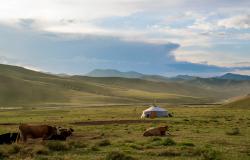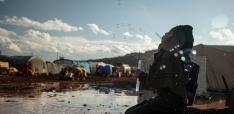Climate Resilience at the Margins: Five Key Lessons from Last Mile Populations

Researchers synthesize climate resilience strategies from five global case studies.
From food and water security to sustainable housing, climate change disproportionately affects populations that are marginalized or hard to reach. Many groups, however, have shown resilience in their response to climate challenges— developing innovative solutions that offer lessons for addressing climate challenges at scale.
In investigating case studies on Mongolia, Philippines, Kenya, Vanuatu, and India, five key factors in climate-response strategies emerged: repurposing existing technology and resources, local ownership, program sustainability, appropriate incentives, and a network of partnerships.
-
Leveraging Existing Technology and Resources
The Renewable Energy for Rural Access Project (REAP) delivered 100,000 solar home systems (SHS) to provide electricity to nomadic herders in Mongolia. Building a solution-specific framework to disseminate SHS would be costly. For this reason, REAP persuaded the soum or district system, existing government entities comparable to county-level administration, to become responsible for distributing and tracking recipients. In areas where the soum structure was insufficient, instead of building additional infrastructure, REAP partnered with private sector entities to distribute and help maintain the SHS. (Local service providers also sold light bulbs, replacement batteries, and television sets―products complementary to the SHS units.) Leveraging existing SHS technology as well as the infrastructure to distribute them gave nomadic herders access to electricity where otherwise prohibited by location and cost.
-
Local Ownership and Engagement
The Alliance of People’s Organizations Along the Manggahan Floodway (APOAMF) Low-Rise Building Project exemplifies how local ownership and engagement can be instrumental to the success of a housing project to reach those affected by flooding in Metro Manila, Philippines. When Typhoon Ketsana struck Manila in 2009, the communities living around the Manggahan Floodway were forcefully evicted. However, the APOAMF, a community-led alliance formed from neighbourhoods along the floodway, helped to develop the Low-Rise Building Project, which built 15 climate-resilient buildings for a total of 900 units across the floodway. Community members were involved throughout the entire project and the governance structure fostered participatory decision making and women-centred leadership. This fostered a strong sense of ownership of the building process and community members were empowered to overcome their challenging circumstances to find an alternative housing solution to eviction.
-
Program Sustainability
The Mikoko Pamoja and Vanga Blue Forest are two initiatives that have employed the use of carbon credits to create development resources in vulnerable communities. The Mikoko Pamoja has engaged their local community in restoring over 8,000 mangroves, a natural infrastructure that protects against extreme weather events and serves as a carbon sink. By creating a financial incentive for locals, the restoration of mangroves serves to reinforce the local community by boosting trade, local ownership, and external partnerships. Locals have capitalized on the conservation of mangroves, creating a source of income that has since been invested back into their communities, and thereby contributing to the development of sanitation, education, health, and environment in their own neighbourhoods. Creating and maintaining a “virtuous” cycle that sustains a program through consistent community development is critical for the long-term success of an intervention.
-
Appropriate Incentives
The Unblocked Cash Project in Vanuatu used blockchain technology to facilitate a cash-and-voucher assistance system, which was pivotal during the aftermath of natural disasters exacerbated by climate change. The provision of near field communication (NFC) cards that allowed beneficiaries to purchase goods directly from local vendors not only facilitated immediate relief but also bolstered the local economy by injecting approximately USD 4.3 million. This approach provided a dual incentive: it empowered disaster-affected individuals by giving them the autonomy to make their own purchasing decisions, thus respecting their dignity and choice, while simultaneously revitalizing local businesses that suffer in postdisaster economies. This model demonstrated a shift from traditional aid-distribution methods toward more sustainable, community-driven recovery processes that can adapt to the increasing challenges posed by climate change.
-
A Network of Partnerships
The UPAVAN project in Odisha, India, was largely successful as a result of its strong network of partnerships, which included local NGOs, government programs, and international research organizations. Digital Green collaborated with local partners and worked within the existing health and agricultural systems to tailor technological solutions to the specific needs of the community, ensuring that the interventions were culturally appropriate and effectively implemented. The involvement of local health workers and community leaders in the dissemination and training processes helped bridge the gap between technology and its practical application on the ground.
Conclusion
Leveraging existing technology and resources, local ownership, program sustainability, appropriate incentives, and a network of partnerships are five factors that are essential to climate interventions that ensure marginalized populations who bear the brunt of climate change burdens do not become excluded. As the world continues to seek solutions to build resilience from the effects of climate change, lessons from Mongolia, Philippines, Kenya, Vanuatu, and India provide valuable insights into the design and implementation of community-based interventions to climate challenges that are both sustainable and inclusive.
Jason M. Lo Hog Tian is a PhD candidate at the University of Toronto examining the social, structural, and behavioural mechanisms through which stigma impacts health for people living with HIV. As a Reach Researcher, he investigates the impact of community-led cooperatives in increasing financial inclusion in Rwanda.
Aisha Shafaqat holds a BA, Political Science from University of Toronto and is a Reach Alliance researcher passionate about creative solutions to achieve greater financial inclusion, economic empowerment, and access to safe and meaningful work.
Safaa Yaseen holds a Master’s in Global Health from University College London, and a bachelor’s in Health Sciences from University of Waterloo in Canada. She is currently a medical student at the University of Birmingham.
Dr. Peter Zhang, PharmD, MBA is a PhD student, a hospital pharmacist, and a Partner, Business Acceleration at a healthtech startup. His works have appeared in research journals such as BMJ Global Health, and in national news outlets in Canada such as the Toronto Star, Globe and Mail, and the National Post.
We would like to acknowledge our fellow researchers on the Mongolia, Philippines, Kenya, Vanuatu, and India Reach Alliance research teams. See case study reports (linked above) for details. The case study research was made possible through the Reach Alliance, founded in 2015 at the University of Toronto’s Munk School of Global Affairs & Public Policy, in partnership with the Mastercard Center for Inclusive Growth.
Photo by munkhbayar dambajav

